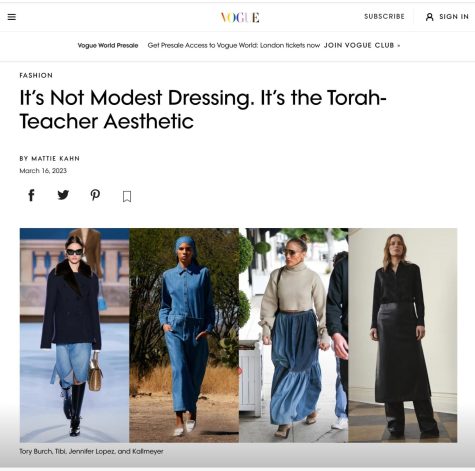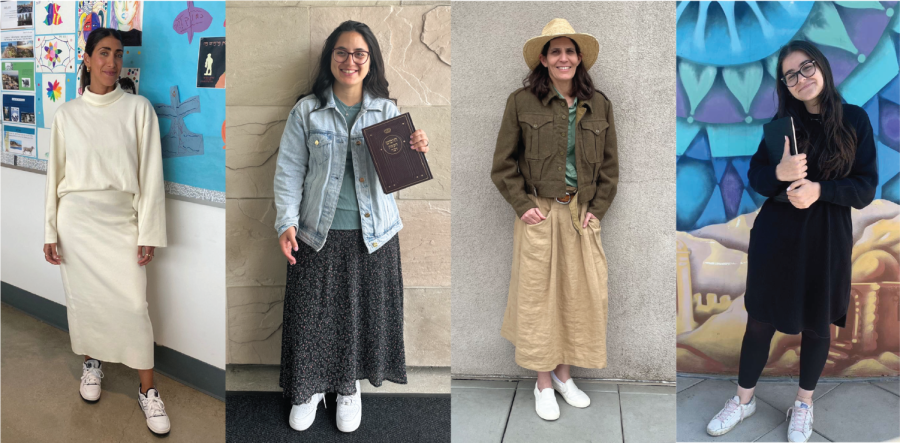BP Photo Illustration by Ezra Helfand
ACTUAL: From left, Shalhevet Judaic Studies staff Natalie Ravanshenas, Mrs. Tova Goldman, Dr. Sheila Keiter and Ms. Mika Shalom wearing what they wore to work that day. Vogue Magazine’s photo, at left below, showed Jennifer Lopez and three models in similar garb.
Vogue Magazine finds something trendy in ‘Torah-Teacher aesthetic’
Magazine says ageless modest dress is actually modern
A recent article in Vogue magazine entitled “It’s not modest dressing, it’s the Torah Teacher aesthetic” describes a current fashion phenomenon that may or may not have to do with the Torah and Jewish practices of dress.
Written by Mattie Kahn, the article describes common fashion staples of the “female Torah-Teacher,” including denim maxi-skirts and loafer shoes, that have now become a part of an aesthetic that fashion designers and big name celebrities are trying to embody.

“It’s an argument and an exploration of boundaries, not unlike biblical exegesis itself,” it says in the article. “Torah-teacher aesthetic is not a trend so much as a puzzle: How can it be channeled without making its wearer look like someone who is running a few minutes late to Talmud class?”
Some Shalhevet teachers love the article, and some find it misleading. Dr. Sheila Keiter teaches two Talmud classes, one Tanakh class, and SAS Eurasia, and she said she thought the article belittled Jewish values of dress rather than promoted them.
“I thought it was mildly offensive and vapid…” said Dr. Keiter. “There’s a presumption that the article comes with that anybody who dresses modestly for religious reasons is frumpy and you wouldn’t want to look like them under any circumstances.”
She said that reflected misconceptions about Jewish women who are religious.
“There seems to be an anti-religious bias in the article that just presumes that oh, we were forced to do this in high school and we would never dress that way ever again of our own free will,’” she said. “It’s pretty uncomplimentary to those who do choose to dress that way for religious reasons. It’s kind of nasty actually.”
Ms. Mika Shalom, a Student Life team member who assists students with Judaic Studies in Ed Support, actually appreciated the article’s focus on Torah-teachers.
“I think that it’s pretty crazy, the fact that they called it Torah teachers – like they could have called it anything,” she said. ‘It could have been ‘the modest look’ or ‘the modest this’ or whatever it is. But it’s cool that they again recognize and they respect how we dress and now it’s like a trend to also dress like that.”
Other Torah teachers at Shalhevet also appreciated the article, and enjoyed seeing some of their styles being worn by today’s fashion icons, like Bella Hadid, Jennifer Lopez and Kendall Jenner.
Eim Bayit Ms. Natalie Ravanshenas is one of them.
“I appreciated the article so much,” Ms. Ravanshenas said. “I love that they put a positive light on dressing modestly, especially in the fashion world and models and all that where it’s usually the opposite.”
The article gives different examples of big name models and celebrities wearing clothes that Vogue considers components of the Torah-teacher aesthetic. The article does not provide an explicit definition of Torah-teacher aesthetic. Rather, it lists some of its central clothing pieces.
For example, it mentions that Kendall Jenner supposedly embraced the Torah-teacher aesthetic when she wore a jean-skirt outfit with loafers.
“What is Torah-teacher aesthetic?” Khan wrote. “Its component parts include, but are not limited to, knee-covering skirts, elbow-covering tops, leggings under dresses, neutral colors, minimal accessorizing, and sneakers with tights. It is related to art teacher dressing but with no fuschia and fewer beaded necklaces.”
According to Vogue, cardigans and Oxford shirts over dresses are also key contributors to the aesthetic.
Junior Leeyah Klyman said she loved the style.
“I love the whole look of it honestly,” said Leeyah, who is a member of Shalhevet’s fashion club. “All of these midi-skirts I’m seeing everywhere and in other Vogue articles, if you see on the runways now, like all these long denim skirts, and like these oversized button down shirts. Everything is just so cute and so chic, and I just really like it.”
But to many Torah-teachers at Shalhevet, modesty means more than a cool fashion trend.
Dr. Keiter said it’s a way to display your internal values.
“You know, what we wear is kind of how we want to present ourselves to the world,” Dr. Keiter said. “Modesty is one part of that message. But in that there are so many other things you can say and present to the world.”
Rabbi Abraham Lieberman, who teaches Talmud, Tanach and Jewish philosophy, said these values can be demonstrated in many different ways, and that the Torah does not give specific guidelines on how Jews should dress.
“There was nothing in the Torah you know, you must wear black, you must wear white shoes…” Rabbi Lieberman said.
“There are in ethical Jewish books ideas of not wearing very hauty or arrogant clothing,” he continued. “You know, don’t walk around with something just to show off. Not that that’s wrong in the sense of, like, they’re gonna violate a commandment, but it’s just the Torah wants people to be humble.”
This gives Jews the ability to express their own personal style while still abiding by Torah laws.
Ms. Ravanshenas said her own personal style has a lot in common with the Torah-teacher aesthetic.
“Oversized sweatshirts with maxi-skirts, pairing it with sneakers,” Ms. Ravanshenas said. “I like to choose one item that kind of looks elevated or like more of a staple, and then dressing it down and then vice versa, taking a very relaxed chill outfit and throwing on a boot or a heel, something a little more fancy. I am very into mixing those two.”
Mrs. Tovah Goldman, an 11th-grade Tanach Teacher and Mashgicha Ruchanit, said she tries to frame her outfits around comfort.
“I’m into looking presentable, and I think that mix of the flowy skirts or the long, or we used to call them ‘duty-length’ skirts actually in high school,” Ms. Goldman said. “But actually now, that’s the style, the midi skirts, with like the basic shirts. I like it.
“I think it’s comfortable, I think it’s just a good in-between of not being too dressed up but not dressing down.”
Dr. Keiter’s adherence to the same halachot of tzniut are little further out of the box than Vogue describes.
“I wear silly hats – that’s my shtick – or vests,” Dr. Keiter said. “Don’t know that that fits into any particular Torah teacher model of dress.”
Although Shalhevet teachers have their own views of modest dressing, Rabbi Lieberman said that Jews have historically been identifiable by their clothing.
“When you look at medieval documents about Jews, they were always identified by the garb,” said Rabbi Lieberman. “Because in some societies, they were forced to wear certain things to identify them as that. But there was the idea of the Jews always were much more modest. By in the norm, especially women, that was noticeable by the non-Jewish world, already over two millennia ago.”
Head of School Rabbi David Block said that Jews’ separation from the rest of society when it comes to dress is a natural consequence of having unique values.
“It’s about the core value of modesty, and that will naturally be different than the rest of society,” said Rabbi Block. “I don’t think the value is to be different than the rest of society – there is value in that– but I think the idea is that the value that we bring to the world is always going to be fundamentally different than.”
Rabbi Block said another aspect of modesty is dressing with professionalism and respect, which is reflected in Shalhevet’s dress code.
“Collared shirts is not halachic…” he said. “A major part of dress is professionalism, and it’s not just about being different, it’s about saying ‘I’m going to engage in something holy, I should dress like I’m holy”
Senior Olivia Fishman said the Vogue article could be helpful for students who find it difficult to follow this dresscode.
“I think it is great for teenage girls who are specifically struggling with the concept of modesty, which many Shalhevet girls do struggle with on a daily basis,” Olivia said. “And I do think it could be inspiring for many people to see celebrities walking around in modest clothing.”
But Dr. Keiter said that there’s a risk to it being a trend.
“On the one hand, if tzniut is cool that’s great, wonderful, it’s cool,” she said. “But on the other hand, it’s Vogue, it’s fashion, and in ‘vogue’ can be out of ‘vogue’ very quickly thereafter.
“So if you take something that has religious value and you make it cool, the problem is is that when it ceases to be cool then it no longer has value, and these things should have transcendent value.”
This story won First Place in Features in the 2024 Jewish Scholastic Journalism Awards of the Jewish Scholastic Press Association, as well as a Certificate of Merit in General Features of the Columbia Scholastic Press Association’s 2024 Gold Circle Awards.
